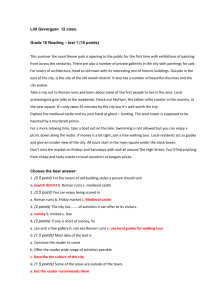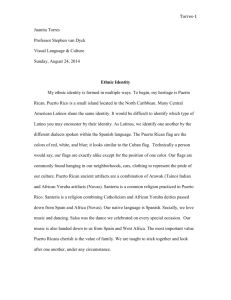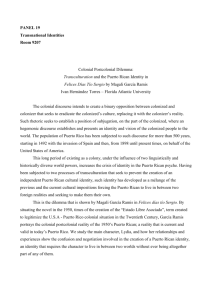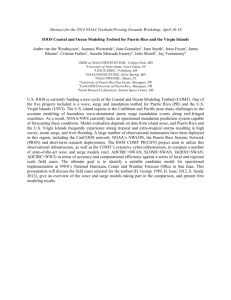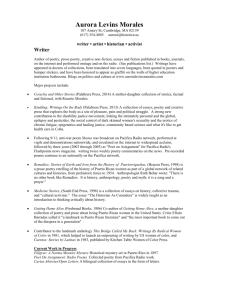Information about Puerto Rico, El Salvador,and
advertisement
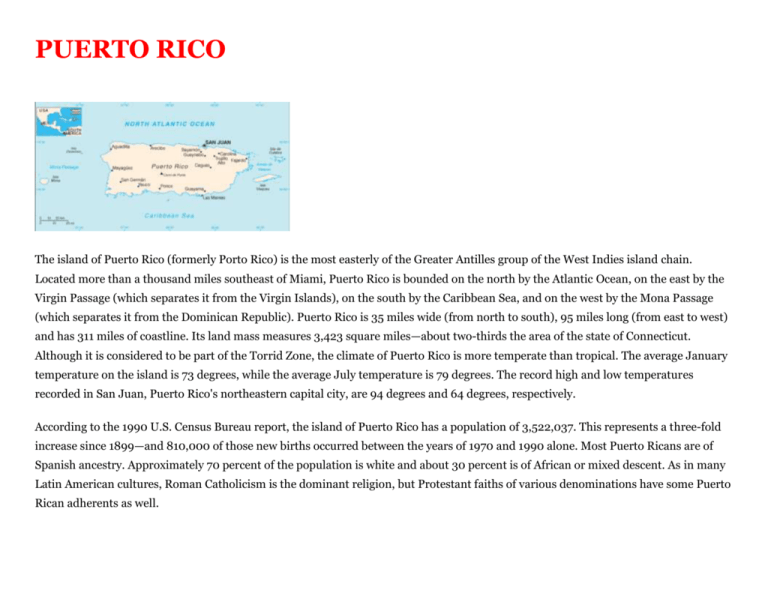
PUERTO RICO The island of Puerto Rico (formerly Porto Rico) is the most easterly of the Greater Antilles group of the West Indies island chain. Located more than a thousand miles southeast of Miami, Puerto Rico is bounded on the north by the Atlantic Ocean, on the east by the Virgin Passage (which separates it from the Virgin Islands), on the south by the Caribbean Sea, and on the west by the Mona Passage (which separates it from the Dominican Republic). Puerto Rico is 35 miles wide (from north to south), 95 miles long (from east to west) and has 311 miles of coastline. Its land mass measures 3,423 square miles—about two-thirds the area of the state of Connecticut. Although it is considered to be part of the Torrid Zone, the climate of Puerto Rico is more temperate than tropical. The average January temperature on the island is 73 degrees, while the average July temperature is 79 degrees. The record high and low temperatures recorded in San Juan, Puerto Rico's northeastern capital city, are 94 degrees and 64 degrees, respectively. According to the 1990 U.S. Census Bureau report, the island of Puerto Rico has a population of 3,522,037. This represents a three-fold increase since 1899—and 810,000 of those new births occurred between the years of 1970 and 1990 alone. Most Puerto Ricans are of Spanish ancestry. Approximately 70 percent of the population is white and about 30 percent is of African or mixed descent. As in many Latin American cultures, Roman Catholicism is the dominant religion, but Protestant faiths of various denominations have some Puerto Rican adherents as well. Puerto Rico is unique in that it is an autonomous Commonwealth of the United States, and its people think of the island as un estado libre asociado, or a "free associate state" of the United States—a closer relationship than the territorial possessions of Guam and the Virgin Islands have to America. Puerto Ricans have their own constitution and elect their own bicameral legislature and governor but are subject to U.S executive authority. The island is represented in the U.S House of Representatives by a resident commissioner, which for many years was a nonvoting position. After the 1992 U.S. presidential election, however, the Puerto Rican delegate was granted the right to vote on the House floor. Because of the Puerto Rico's commonwealth status, Puerto Ricans are born as natural American citizens. Therefore all Puerto Ricans, whether born on the island or the mainland, are Puerto Rican Americans. Puerto Rico's status as a semiautonomous Commonwealth of the United States has sparked considerable political debate. Historically, the main conflict has been between the nationalists, who support full Puerto Rican independence, and the statists, who advocate U.S. statehood for Puerto Rico. In November of 1992 an island-wide referendum was held on the issue of statehood versus continued Commonwealth status. In a narrow vote of 48 percent to 46 percent, Puerto Ricans opted to remain a Commonwealth. HISTORY Read more: Puerto Rican Americans - History, Modern era, Early mainlander puerto ricans, Significant immigration waves http://www.everyculture.com/multi/Pa-Sp/Puerto-Rican-Americans.html#ixzz1okr576Dw CUISINE CUISINE CUISINE Puerto Rican cuisine is tasty and nutritious and consists mainly of seafood and tropical island vegetables, fruits, and meats. Although herbs and spices are used in great abundance, Puerto Rican cuisine is not spicy in the sense of peppery Mexican cuisine. Native dishes are often inexpensive, though they require some skill in preparation. Puerto Rican women are traditionally responsible for the cooking and take great pride in their role. Many Puerto Rican dishes are seasoned with a savory mixture of spices known as sofrito ("so-FREE-toe"). This is made by grinding fresh garlic, seasoned salt, green peppers, and onions in a pilón ("pee-LONE"), a wooden bowl similar to a mortar and pestle, and then sautéing the mixture in hot oil. This serves as the spice base for many soups and dishes. Meat is often marinated in a seasoning mixture known as adobo, which is made from lemon, garlic, pepper, salt, and other spices. Achiote seeds are sautéed as the base for an oily sauce used in many dishes. Aranitas_tostones.jpg Bacalodo ("bah-kah-LAH-doe"), a staple of the Puerto Rican diet, is a flaky, salt-marinated cod fish. It is often eaten boiled with vegetables and rice or on bread with olive oil for breakfast. Arroz con pollo, or rice and chicken, another staple dish, is served with abichuelas guisada ("ah-bee-CHWE-lahs gee-SAH-dah"), marinated beans, or a native Puerto Rican pea known as gandules ("gahnDOO-lays"). Other popular Puerto Rican foods include asopao ("ah-soe-POW"), a rice and chicken stew; lechón asado ("le-CHONE ahSAH-doe"), slow-roasted pig; pasteles ("pah-STAY-lehs"), meat and vegetable patties rolled in dough made from crushed plantains (bananas); empanadas dejueyes ("em-pah-NAH-dahs deh WHE-jays"), Puerto Rican crab cakes; rellenos ("reh-JEY-nohs"), meat and potato fritters; griffo ("GREE-foe"), chicken and potato stew; and tostones, battered and deep fried plantains, served with salt and lemon juice. These dishes are often washed down with cerveza rúbia ("ser-VEH-sa ROO-bee-ah"), "blond" or light-colored American lager beer, or ron ("RONE") the world-famous, dark-colored Puerto Rican rum. Read more: Puerto Rican Americans - History, Modern era, Early mainlander puerto ricans, Significant immigration waves http://www.everyculture.com/multi/Pa-Sp/Puerto-Rican-Americans.html#ixzz1okqosLxu Read more: Puerto Rican Americans - History, Modern era, Early mainlander puerto ricans, Significant immigration waves http://www.everyculture.com/multi/Pa-Sp/Puerto-Rican-Americans.html#ixzz1okqh57rL EL SALVADOR The smallest of the Central American states, the Republic of El Salvador measures 21,041 square kilometers—about the size of the state of Massachusetts—and has a population of approximately five million. Situated near the northern end of the Central American isthmus, it is bordered by Guatemala to the northwest, Honduras to the northeast, and the Pacific Ocean to the south. A Spanish-speaking country, El Salvador was given its name—which means "the Savior," referring to Jesus Christ—by the Spanish. Its flag consists of horizontal stripes, two blue and one white, with the national coat of arms in the center. This coat of arms contains branches, flags, green mountains, and the words "Republica de El Salvador en la America Central" and "Dios Union Libertad." Also pictured in the center of the flag are a small red liberty cap and the date of El Salvador's independence from Spain: September 15, 1821. Two volcanic mountain ranges dominate El Salvador's landscape; they run parallel to each other, east to west, along the length of the country. Just to the north of the southern range lies a broad central plain, the most fertile and populous region of El Salvador, which includes the nation's capital city, San Salvador, and a handful of smaller cities. These urban areas have grown significantly in recent years and by the mid-1990s housed more than half the population of El Salvador. But because El Salvador's economy is largely agricultural, a considerable portion of the population remains in the countryside to work the coffee plantations and other farms. CUISINE CUISINE Salvadoran food is similar to Mexican food but is sweeter and milder. The foundation of the diet is cornmeal tortillas (thicker than the Mexican variety), rice, salt, and beans. The most popular national snack is the pupusa, a cornmeal griddle-cake stuffed with various combinations of cheese, spices, beans, and pork. Pupusas are served with curtido, a cabbage and carrot salad made with vinegar. A more substantial meal is salpicón, minced beef cooked with onions and chilies and served with rice and beans. For dessert, many dishes include fried or stewed bananas. Chicha, a sweet drink made from pineapple juice, is a popular beverage. The best Salvadoran food is found in private homes, but many Salvadoran restaurants and food stands have opened in Los Angeles and other cities where Salvadoran Americans live. Both in El Salvador and in Salvadoran American neighborhoods, people love to buy food from street vendors. Popular street foods include pupusas and mango slices—spiced with salt, lime juice, red pepper, and crushed pumpkin and sesame seeds. Read more: Salvadoran Americans - History, Modern era, Salvadorans in america, Significant immigration waves http://www.everyculture.com/multi/Pa-Sp/Salvadoran-Americans.html#ixzz1oktJak10 Read more: Salvadoran Americans - History, Modern era, Salvadorans in america, Significant immigration waves http://www.everyculture.com/multi/Pa-Sp/Salvadoran-Americans.html#ixzz1oktASCeL BOLIVIA Bolivia, the only landlocked country in the Western Hemisphere, is home to almost eight million people. Twice as large as Texas, Bolivia is a multiethnic society. Of all the South American countries, Bolivia has the largest percentage (60 percent) of indigenous Indians. The next largest ethnic group in the Bolivian population is the mestizos, those of mixed-race heritage; they make up 30 percent. Finally, 10 percent of the Bolivian population are of Spanish origin. These figures mask the true breadth of the Bolivian population map. The largest ethnic groups are the highland Indians—the Aymara and the Quechua. The most ancient people of the Andes may be the ancestors of the Aymara, who formed a civilization as early as 600 A.D. The rural lowland regions are home to more ethnic diversity. Other Indian groups include the Kallawayas, the Chipayas, and the Guarani Indians. Ethnicities from most of the other South American countries are represented in Bolivia, as well as people of Japanese descent and origin. Those known as Spanish are called "Whites," not so much for their skin color as for their social status, identified by physical characteristics, language, culture, and social mobility. The blending and intermarriage of races for over 500 years has made Bolivia a heterogeneous society. Bolivia is bordered to the west by Chile and Peru, to the south by Argentina, to the southeast by Paraguay, and to the east and north by Brazil. One of the most striking features of Bolivia, its high plateau, or Altiplano, is also home to most of its population. The Altiplano sits between two chains of the Andes mountains and it is one of the highest inhabited regions in the world, reaching an average height of 12,000 feet. Although it is cold and windswept, it is the most densely populated region of the country. The valleys and ridges of the Andes' eastern slopes are called the Yungas, where 30 percent of the country's population lives and 40 percent of the cultivated land sits. Finally, three-fifths of Bolivia are sparsely populated lowlands. The lowlands include savannas, swamps, tropical rainforests, and semi-deserts. Read more: Bolivian Americans - History, Modern era, Settlement patterns, Acculturation and Assimilation http://www.everyculture.com/multi/ABr/Bolivian-Americans.html#ixzz1okspp1af CUISINE CUISINE As in most countries, the Bolivian diet is influenced by region and by income. Most meals in Bolivia, however, include meat, usually served with potatoes, rice, or both. Another important carbohydrate is bread. Near Santa Cruz are large wheat fields, and Bolivia imports large quantities of wheat from the United States. In the highlands, potatoes are the staple food. In the lowlands, the staples are rice, plantain, and yucca. Fewer fresh vegetables are available to those in the highlands. Some popular Bolivian recipes include silpancho, pounded beef with an egg cooked on top; thimpu, a spicy stew cooked with vegetables; and fricase, pork soup seasoned with yellow hot pepper. Also central to the urban Bolivian diet is street food, such as saltenas, oval pies, stuffed with various fillings and eaten as a quick meal. They are similar to empanadas, which are usually filled with beef, chicken, or cheese. Diets in the lowlands include wild animals such as the armadillo. The most common Bolivian drink is black tea, which is usually served strong with lots of sugar. In urban areas, most Bolivians eat a very simple breakfast and a large, relaxed, and elaborate lunch. On weekends, lunch with friends and family is a major event. Often, lunch guests remain long enough to stay for dinner. In La Paz a popular dish is anticuchos, pieces of beef heart grilled on skewers. The cuisine in rural areas is simpler and only two meals are eaten per day. Native families usually eat outside. Bolivians who live in rural areas are often uncomfortable eating in front of strangers. Therefore, when they must eat in a restaurant, they often face toward a wall. Eating in front of strangers makes a Bolivian in rural areas feel uncomfortable. Thus, men, particularly, will face a wall when they eat if they must do so away from home. Read more: Bolivian Americans - History, Modern era, Settlement patterns, Acculturation and Assimilation http://www.everyculture.com/multi/ABr/Bolivian-Americans.html#ixzz1okrzZKDa

